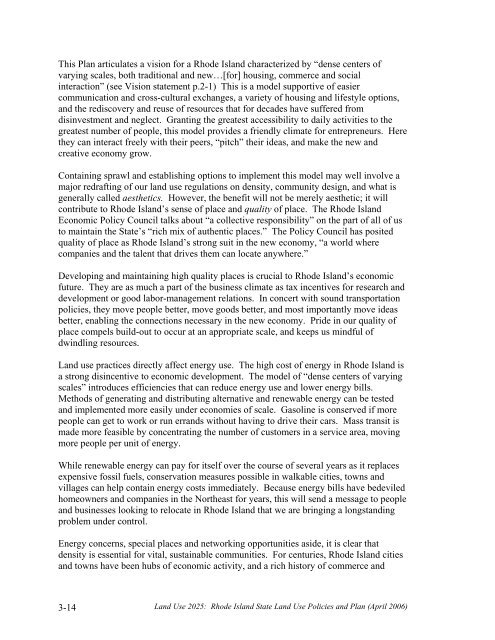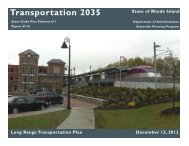Land Use 2025 - RhodeMap RI
Land Use 2025 - RhodeMap RI
Land Use 2025 - RhodeMap RI
- No tags were found...
You also want an ePaper? Increase the reach of your titles
YUMPU automatically turns print PDFs into web optimized ePapers that Google loves.
This Plan articulates a vision for a Rhode Island characterized by “dense centers ofvarying scales, both traditional and new…[for] housing, commerce and socialinteraction” (see Vision statement p.2-1) This is a model supportive of easiercommunication and cross-cultural exchanges, a variety of housing and lifestyle options,and the rediscovery and reuse of resources that for decades have suffered fromdisinvestment and neglect. Granting the greatest accessibility to daily activities to thegreatest number of people, this model provides a friendly climate for entrepreneurs. Herethey can interact freely with their peers, “pitch” their ideas, and make the new andcreative economy grow.Containing sprawl and establishing options to implement this model may well involve amajor redrafting of our land use regulations on density, community design, and what isgenerally called aesthetics. However, the benefit will not be merely aesthetic; it willcontribute to Rhode Island’s sense of place and quality of place. The Rhode IslandEconomic Policy Council talks about “a collective responsibility” on the part of all of usto maintain the State’s “rich mix of authentic places.” The Policy Council has positedquality of place as Rhode Island’s strong suit in the new economy, “a world wherecompanies and the talent that drives them can locate anywhere.”Developing and maintaining high quality places is crucial to Rhode Island’s economicfuture. They are as much a part of the business climate as tax incentives for research anddevelopment or good labor-management relations. In concert with sound transportationpolicies, they move people better, move goods better, and most importantly move ideasbetter, enabling the connections necessary in the new economy. Pride in our quality ofplace compels build-out to occur at an appropriate scale, and keeps us mindful ofdwindling resources.<strong>Land</strong> use practices directly affect energy use. The high cost of energy in Rhode Island isa strong disincentive to economic development. The model of “dense centers of varyingscales” introduces efficiencies that can reduce energy use and lower energy bills.Methods of generating and distributing alternative and renewable energy can be testedand implemented more easily under economies of scale. Gasoline is conserved if morepeople can get to work or run errands without having to drive their cars. Mass transit ismade more feasible by concentrating the number of customers in a service area, movingmore people per unit of energy.While renewable energy can pay for itself over the course of several years as it replacesexpensive fossil fuels, conservation measures possible in walkable cities, towns andvillages can help contain energy costs immediately. Because energy bills have bedeviledhomeowners and companies in the Northeast for years, this will send a message to peopleand businesses looking to relocate in Rhode Island that we are bringing a longstandingproblem under control.Energy concerns, special places and networking opportunities aside, it is clear thatdensity is essential for vital, sustainable communities. For centuries, Rhode Island citiesand towns have been hubs of economic activity, and a rich history of commerce and3-14<strong>Land</strong> <strong>Use</strong> <strong>2025</strong>: Rhode Island State <strong>Land</strong> <strong>Use</strong> Policies and Plan (April 2006)
















